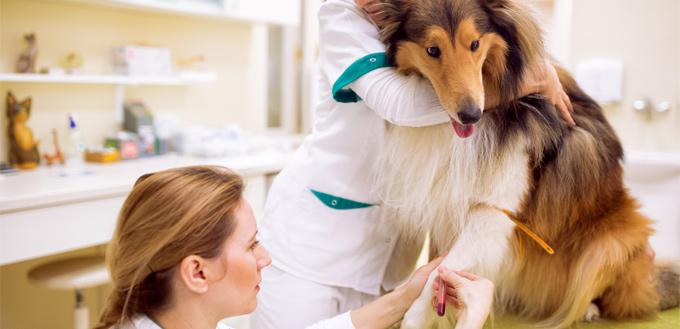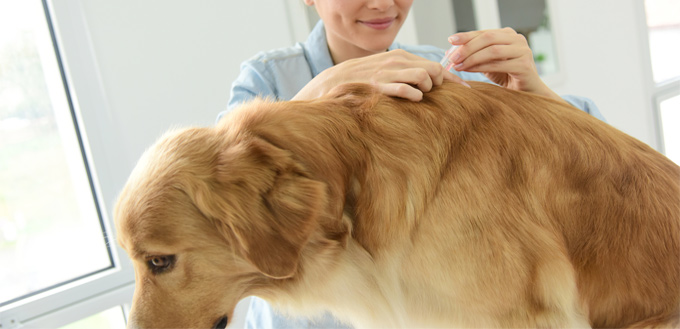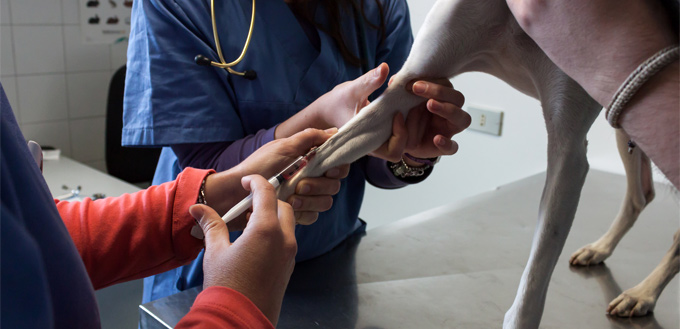It may not be something you have thought about before and, hopefully, it will never be something you need in your life. But did you know that your canine companion can save another dog’s life by giving blood? In fact, every unit of blood your dog donates can save up to 4 other dogs. One dedicated pet centre in the UK sent out over 5,000 donations last year- that’s a lot of furry friends who got to stay with us, due to the kindness of their fellow pups. If you’re interested in learning more about the process of dog blood donation, as well as how you can get involved, read on. We’ve created this article to answer some of the more common questions and, hopefully, convince you to get involved!
What Is The Difference Between Human And Dog Blood?
All blood runs under the same operation to carry oxygen through the bloodstream from the lungs, to the vital organs that require oxygen to survive. In this sense, there is no difference between human blood and canine blood. However, our blood cells are actually massively complex and- when a foreign body is present in the bloodstream- your body releases antibodies, which attack the unknown presence, destroying it and/or making the recipient iller than they were previously. If a human were to have a transfusion of animal blood, it’s very likely that the body would respond by going into shock- and the results would be deadly. This is why it’s really important to match up blood types in both humans and animals, as well as why we can’t cross-donate blood transfusions.

It all comes down to what proteins make up the blood cells of each animal. In fact, these proteins can even differ from person to person, in the same way, that dog blood can differ from canine to canine. So, not only would you need to have another dog to donate blood, but the blood itself would need to match up exactly to your dog’s blood type.
Can My Dog Be A Blood Donor?
Much like us humans, there are many dog blood donation rules. If you were wondering what the criteria are for dog blood donation, we’ll compile a handy guide below. This isn’t all-encompassing, but it should give you a good idea as to whether or not your dog is eligible for blood donation.
- Age
Doggy donors need to be aged between 1 and 7 years old. This is basically to ensure that your dog is both fully matured and not too old to suffer from any negative repercussions of having some of their blood taken.
- Weight
A good weight for most dogs is over 40lbs. Again, ensuring that your dog is at a healthy weight before donating means that there are no concerns of any underlying health issues, as well as double-checking that your dog won’t suffer from any drawbacks, once the process is complete.
- Health and fitness
By this, we mean that all dogs who are interested in donating must have a good respiration rate, maintain a healthy heart rate and have a normal temperature. This stops any possibilities of cross-contamination (if your dog has a canine-cold, for example) from your dog to a pup that is already very poorly. It also means that your dog is healthy and happy to have to their blood taken.
- Medication
Naturally, your dog won’t be able to give blood if they’re on medication. Since the blood will go to a sick pup, medication may have an adverse reaction to any prescribed medications that the recipient may already be on. It also stops any risks of allergies occurring, or any danger of the blood being rejected, which can be deadly.
- Travel
Since there are many airborne viruses and bacteria around, it’s essential that your dog has never travelled out of the country. This is the case whether or not your dog appeared or became ill, or not. While it might seem a little unfair, it’s because some illnesses or diseases can lay dormant in your dog but other dogs may not be so lucky. Especially since the dog who is receiving the blood can often be suffering from many immune-debilitating health problems, meaning they simply won’t have the strength or antibodies to fight off an infection.
- Vaccinated
As above, it’s vitally important that there is no risk whatsoever of cross-contamination. So, if your dog hasn’t been fully vaccinated, they won’t be able to give blood. For recipients of blood donation, it is essential that there is no risk of becoming infected for the reasons stated in the “travel” section of this post.
- Good temperament
No good vet will force a dog to go through blood donation if they become anxious or aggressive before, during or after the procedure. Not only this, but your dog will need to be sat still for up to 15 minutes so that there’s no danger of the needle coming out in the middle of the process. While most dogs are happy to munch down on some treats during this process, there are some dogs that are simply too excitable to be blood donors, I’m afraid. This doesn’t mean that they’re a bad dog- just that it’s better for everyone if your dog is comfortable and calm.
There can sometimes be other reasons why your vet or donation centre decides not to accept your dog’s blood, which is within their rights as animal specialists. It’s also a good idea to have a chat with your vet, if your dog is refused for blood donation, to see if what the reasons are and what can be done to ensure your dog is as healthy and happy as it can be.
Is It Safe For My Dog To Donate Blood?
If your dog passes all the checks listed above and your vet has no concerns about your dog giving blood, it is absolutely safe for your pup to become a blood donor. Your dog may be a little lethargic after having their blood taken, although this is rare. Indeed, your dog should be none-the-worse for their living-giving donation and should be right as rain within 24 hours. Their blood is regenerated and is back to being “full” in around two months. This means that dogs can donate their blood up to 6 times a year! Great news for those who may have serious health issues, which can be alleviated via a blood transfusion.

Will Dog Blood Donation Hurt My Dog?
While the process of donating blood is helpful, it can feel a little weird (speaking from personal experience!) and your dog may show this discomfort if there isn’t anything to distract him or her. That said, they usually prefer to focus on dog treats and fuss during this time, so any visible signs of this haven’t been reported as yet.
Naturally, it may sting a little when the needle breaks the skin or when it’s being pulled out, though dogs are fairly hardy creatures and the feedback from most dog owners is that their dog didn’t make a fuss or seem bothered at all.
How Many Dog Blood Types Are There?
Like their human counterparts, dogs can indeed have different blood types, and these are referred to as DEA. The most popular blood type is DEA 1. Within this, a dog can be positive or negative, in the same way, that humans are. These are classified under DEA 1.1 and DEA 2.1. There are also several other types, although these are rarer which consist of DEA 3, DEA 4, DEA 5, DEA 7. Still with me? Good, because if that wasn’t information overload, you might be interested to know that some Dalmatians have their antigen- which has been named the DAL antigen.
The Blue Ridge Veterinary Blood Bank (one of 6 doggy donation centres in the US) spoke to me about the blood type their most common test – the DEA 1.1, which is considered to be the most important blood type, as well as one of the most popular (dogs with DEA 1.1 account for an estimated 30-45% of canines). Dogs with a 1.1 blood type are referred to as universal recipients, in that they can receive any blood type from any dog. Of course, a dog with 1.1 blood isn’t able to give to all dogs, even though all dogs with this can be a recipient. If the poorly pup needs another blood type, then the vet will need to find a dog donation that matches this.
All blood donations are tested for their type before being sent off to the blood bank, so don’t worry too much about what type your dog has. Most vets are happy to answer your questions regarding this, so feel free to a little digging if you’d like to know more.

How Does Blood Donation Work?
The process of doggy donations couldn’t be simpler. The process may vary from clinic to clinic but most of the fundamental aspects stay the same and your assigned vet will usually be more than happy to put your mind at ease, if you’re unsure about anything, during any part of the donation.
- You register your interest
Since canine blood donation is still considered a little unusual, it would be up to you to register your dogs and your interest in undergoing the procedure. Most places will give you a call and go over some of the details, as well as answering your questions. This is a great way to get to know the clinic, so don’t be afraid to have a good chat!
- Preliminary checks and preparations are conducted
Your vet and your pooch will naturally introduce themselves to each other and then the clinician will go over some of the basic checks that we mentioned earlier. The next step is to get the fur shaved in the area the needle will go on- some vets like to use a leg, while others are more likely to choose the neck since these are proven to be great veins for blood donation. In the UK, your dog might also be microchipped at this point, if they haven’t been already.
- Donation
The shaved area is cleaned and disinfected, to make sure your pup won’t get any nasty side effects caused by poor hygiene standards. Then, in goes the needle! At this point, it can be fascinating to watch the bag filled with up to 450ml of your dog’s life-saving blood, but it’s also a good idea to have a chat with the vet and put your mind at ease. Your dog will follow your lead on all things, so remaining calm and chatting can have a very easing effect on your pup.
It also helps that most vets will encourage cuddles and treats at this point, so your dog will be fussed and happy. If your pooch is showing signs of too much anxiety or there are any issues, the donation will be stopped. No vet will consciously hurt an animal, so don’t worry if it turns out they’re unhappy about the needle or similar.
- Dog treats and a toy
The needle then comes out and the donation is safely packaged away, ready to go to the blood bank. In the meantime, your brave soldier will receive a good drink and a few dog treats to thank him for his time and energy- some clinics will even give them a new dog toy to play with!
- Home
You’re all done. It’s time to go home and relax for 24 hours. Keep an eye on your pooch and remember to be proud- both you and they have done an amazing thing!
While dog donation sounds like a huge process, it’s really very easy and has little-to-no effect on our puppy pals. If dog blood donation sounds like something you’d be interested in, then get in contact with your nearest centre and register your interest, today!
Note: The advice provided in this post is intended for informational purposes and does not constitute medical advice regarding pets. For an accurate diagnosis of your pet's condition, please make an appointment with your vet.





